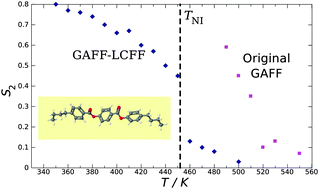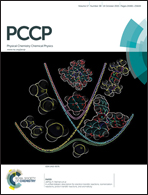Optimization of the GAFF force field to describe liquid crystal molecules: the path to a dramatic improvement in transition temperature predictions†
Abstract
The physical properties and phase transitions of thermotropic liquid crystals are highly sensitive to small changes in chemical structure. However, these changes are challenging to model, as both the phase diagram and mesophase properties obtained from fully atomistic simulations are strongly dependent on the force field model employed, and the current generation of chemical force fields has not proved accurate enough to provide reliable predictions of transition temperatures for many liquid crystals. This paper presents a strategy for improving the nematic clearing point, TNI, in atomistic simulations, by systematic optimization of the General Amber Force Field (GAFF) for key mesogenic fragments. We show that with careful optimization of the parameters describing a series of liquid crystal fragment molecules, it is possible to transfer these parameters to larger liquid crystal molecules and make accurate predictions for nematic mesophase formation. This new force field, GAFF-LCFF, is used to predict the nematic–isotropic clearing point to within 5 °C for the nematogen 1,3-benzenedicarboxylic acid,1,3-bis(4-butylphenyl)ester, an improvement of 60 °C over the standard GAFF force field.


 Please wait while we load your content...
Please wait while we load your content...